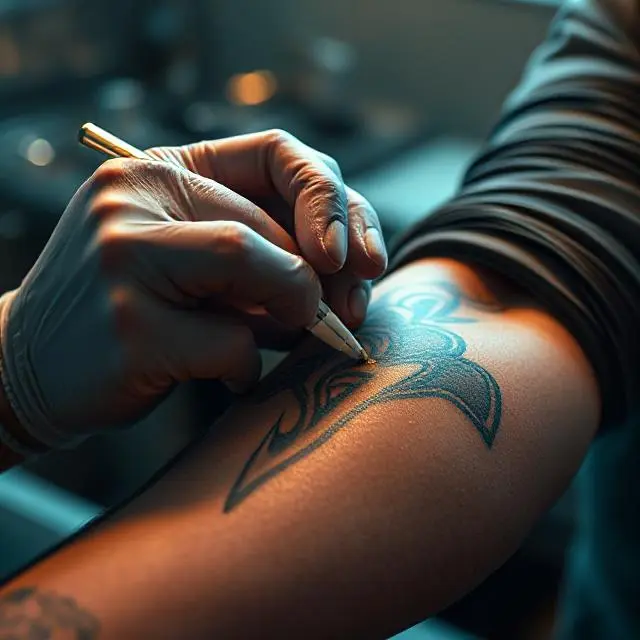Tattoo numbing cream is a topical treatment designed to reduce pain and discomfort during the process of getting a tattoo. It typically contains active ingredients like lidocaine or benzocaine, which temporarily numb the skin and block nerve impulses conducting pain. By using numbing cream before attending your tattoo session, you are able to reduce a lot of the pain caused by the tattoo needle. The cream usually starts to take effect 20-30 minutes after it is applied and can last for 1-2 hours.
What are the reasons people use numbing cream when they get a tattoo?
There are a number of reasons why people use numbing cream when they get a tattoo. The main one is the avoidance of pain. There are some parts of the body that are extremely sensitive, for example, the ribs, spine, or inside of the arm, and they are much more painful.

For those with low tolerance for pain or fear of the tattooing process, numbing cream is one of the options to endure the process. It may also be employed in large tattoos or intricate tattoos in which the process may take hours.
What is the science behind tattoo numbing cream operation?
Numbing creams used to get a tattoo have a local anesthetic in them, commonly lidocaine. Lidocaine works by blocking the messages the nerves send to the brain, which is effectively numbing the area you put it on. This prevents the pain the tattoo needle induces from traveling up to the brain, and so it is less painful. It will usually take 20–30 minutes to be noticeable and last about 1–2 hours depending on what you’re using and the type of your skin.
How soon prior to your session should you apply the numbing cream?
Make sure to apply the numbing cream 30-45 minutes before your tattoo session. Applying it too early may cause the numbing effect to wear off before the tattoo artist starts, while applying too late might reduce its effectiveness. To get the best out of it, make sure to read the instructions carefully and give the cream sufficient time to penetrate into the skin.
Can numbing cream cause any unwanted effects or side effects?
While numbing cream can help ease the process, there are risks associated. Numbing cream, for example, can cause irritation, allergies, or swelling when not applied correctly. Some may experience redness or rash where the application took place. In rare cases, excessive use of numbing cream can lead to systemic side effects such as dizziness or cardiac problems. You should do a patch test before applying the cream to ensure that you are not allergic to it. Always follow the instructions and your tattoo artist before you use numbing cream since some artists do not want to work with people who have been numbed out of concern over skin texture or quality of the tattoo. Do You Have to Use Numbing Cream for All Tattoos?
Is every tattoo going to need numbing cream, or are there tattoos that don’t need it?
There are people with a higher pain threshold and they can sit through the tattooing without any need for numbing assistance. If you’re getting a small tattoo placed on a less nerve-heavy part of your body, like your upper arm, you may not need numbing cream. But for bigger tattoos, more sensitive areas (such as the ribs, knees, or neck), or those with a lower tolerance for pain, numbing cream can make the experience more bearable.
What’s the right way to apply numbing cream to get the best out of it?
To apply numbing cream correctly, do the following:
- Clean the Site: Wash the area where the tattoo will be done with soap and water, ensuring that it is clean and oil-free.
- Apply a Rich Layer: Apply a rich layer of numbing cream to the area. Ensure that it is spread evenly.
- Cover with Plastic Wrap: Cover the area with plastic wrap to enable the cream to seep into the skin.
- Wait for 30-45 Minutes: Apply the cream for approximately 30-45 minutes before your tattoo appointment. This will numb your skin.
- Remove the Cream: The artist will clean the skin so that the cream is removed and the tattooing can proceed.
Does numbing cream have any impact on the appearance or healing of your tattoo?
The application of numbing cream normally won’t make a difference in the quality of your tattoo, but there’s a small possibility. There are artists who are of the opinion that numbing creams will distort the texture of the skin and make it difficult for the tattoo needle to cut smoothly. It can influence the absorption of ink and result in bad shading or jagged lines. However, the majority of artists have no difficulty working with clients applying numbing cream, and the risks are minimal if the product is used as directed. Are There DifferentWhat are the various kinds of numbing creams for tattoos?
There are various numbing creams and gels available for tattoos, which vary mainly in terms of active ingredient and concentration. Some of the best known numbing agents are:- Lidocaine: Since it’s such a great skin numbing product with a duration of as long as 2 hours.
- Benzocaine: Generally contained in over-the-counter numbing creams, though not quite as strong as lidocaine.
- Tetracaine: Stronger than lidocaine, but lesser known.